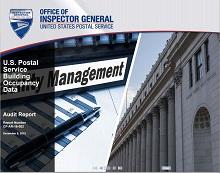U.S. Postal Service Building Occupancy Data
Background
The U.S. Postal Service develops costs by segments and components for its Cost and Revenue Analysis report. Cost Segment 15 contains building occupancy cost data covering expenses for renting and leasing facilities, fuel and utilities, communications, and facility improvements.
Total building occupancy costs for fiscal year (FY) 2014 totaled $1.8 billion. Management develops these costs for the Annual Compliance Report (ACR). The Postal Accountability and Enhancement Act of 2006 requires the U.S. Postal Service Office of Inspector General (OIG) to regularly audit data collection systems and procedures used to collect information and prepare the ACR. The Postal Service’s 1999 Facility Space Usage Study is the primary data source used to determine the allocation of rental expenses to products. The 1999 study surveyed 724 Postal Service facilities, covering over 17 percent of total space.
Our objective was to determine whether network and operational changes are accurately reflected in building occupancy costs for the FY 2014 ACR.
What the OIG Found
Building occupancy costs reported in the FY 2014 ACR do not accurately reflect current network and operational changes because the latest study was completed in 1999 and the Cost Attribution group is unable to clearly identify or provide a documented process for their annual updates to facility space usage data. Since 2006, the Postal Service has closed or consolidated more than 350 facilities and made significant operational changes, such as deployment of new equipment and retirement of old equipment. Also, over 140 of the 724 facilities (or 20 percent) surveyed for the 1999 study are no longer in use. The Cost Attribution group’s management agrees that a new study is needed, but has not conducted one because of limited resources.
We also found that the methodology used by the Postal Service to attribute costs to products is outdated. Although the Postal Service follows a methodology approved by the Postal Regulatory Commission, we found that it can result in inaccurate attribution of building occupancy rent expenses to mail products. Vacant space costs and a portion of utilities and communication costs are generally considered institutional because they are not generated by any particular product. In 1976 the Postal Regulatory Commission stated that these costs should not be attributed to mail products; however, the methodology the Postal Service uses to attribute costs to products has this result.
What the OIG Recommended
We recommended the chief financial officer and executive vice president conduct and document a new facility space usage study reflecting current network and facility operations, establish procedures for updating facility space data annually, and establish criteria for conducting new facility space usage studies. We also recommended management update the methodology for attributing costs to products so that costs that should be deemed institutional are not attributed to products and evaluate opportunities to use automated sources of data to make the facility space usage study and its updates more accurate and cost effective.

